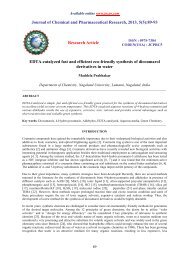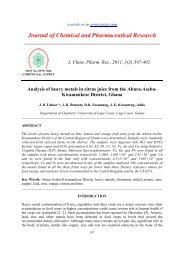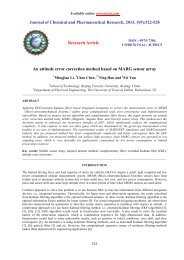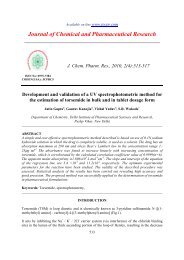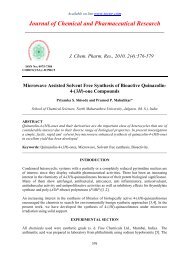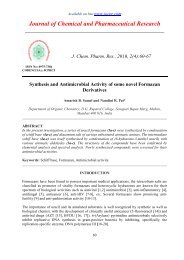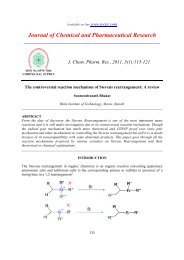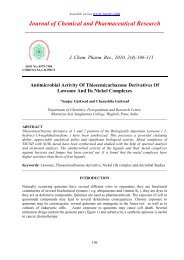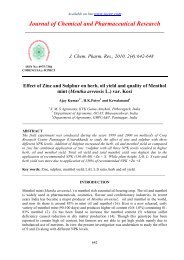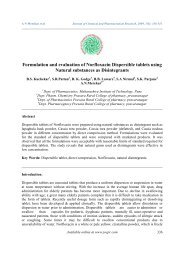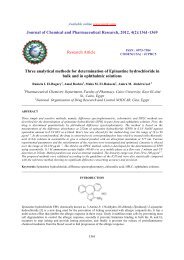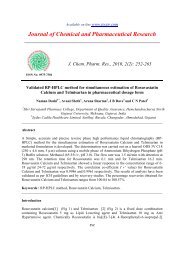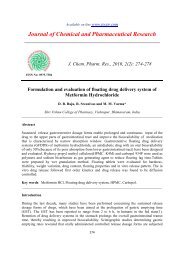Kinetics of a Reaction of 3-Chloroacetylacetone with Thioureas
Kinetics of a Reaction of 3-Chloroacetylacetone with Thioureas
Kinetics of a Reaction of 3-Chloroacetylacetone with Thioureas
You also want an ePaper? Increase the reach of your titles
YUMPU automatically turns print PDFs into web optimized ePapers that Google loves.
B. H. Zaware et al Journal <strong>of</strong> Chemical and Pharmaceutical Research, 2009, 1(1): 276-281_____________________________________________________________________________________________<strong>Kinetics</strong> <strong>of</strong> a <strong>Reaction</strong> <strong>of</strong> 3-<strong>Chloroacetylacetone</strong> <strong>with</strong> <strong>Thioureas</strong>a B. H. Zaware*, b R. A. Mane and c S. R. Kuchekara New Arts Commerce and Science College, Ahmednagar (M. S.), Indiab Department <strong>of</strong> chemistry, Dr. Babasaheb Ambedkar Marathwada University, Aurangabadc Post Graduate Department <strong>of</strong> chemistry, P.V.P. College Pravaranagar, Loni_____________________________________________________________________________AbstractThe kinetic study <strong>of</strong> 3-chloroacetylacetone and thioureas has been carried out in ethanol.<strong>Thioureas</strong> used for study are thiourea, phenyl thiourea, p-methyl phenyl thiourea, p-ethoxyphenyl thiourea and p-chlorophenyl thiourea. The second order rate constants for these reactionwere reported. The rate <strong>of</strong> reaction is first order <strong>with</strong> respect to 3-chloroacetylacetone and firstorder <strong>with</strong> respect to thioureas. The effect <strong>of</strong> substituents on the rate <strong>of</strong> reaction was also studied.Thermodynamic parameters are used to explain the nature <strong>of</strong> the reaction. The reaction productsare isolated and characterized. Possible reaction mechanism for the reaction will be proposed anddetails <strong>of</strong> the kinetics will be discussed.Key words: <strong>Kinetics</strong>, <strong>Reaction</strong>, 3-<strong>Chloroacetylacetone</strong>, Thiourea.______________________________________________________________________________Introduction<strong>Thioureas</strong> are commercially used in photographic films, plastics and textiles. <strong>Thioureas</strong> haveshown antibacterial, fungicidal[1], hypnotic and antipyretic[2] activities. Some <strong>of</strong> the thioureasare screened for anticancer activity[3-5]. The use <strong>of</strong> thiozoles as a vulcanizing accelerators anddye intermediates has been reported[6].Kinetic and thermodynamic studies on reactions <strong>of</strong> Pt(II) complexes <strong>with</strong> pyrozole and 1,2,3triazole has been carried out[7]. <strong>Reaction</strong> kinetics <strong>of</strong> gold dissolution in acid thiourea solutionusing ferric sulphate as a oxidant was investigated <strong>with</strong> rotating disk technique[8]. <strong>Kinetics</strong> andmechanism <strong>of</strong> reactions between thiourea and iodate in buffer medium has been studied[9]. Thekinetics <strong>of</strong> the reaction <strong>of</strong> thiourea <strong>with</strong> formaldehyde was studied[10].<strong>Kinetics</strong> <strong>of</strong> oxidation <strong>of</strong> thioureas by using various oxidizing agents has been studied[11]. Thekinetic study <strong>of</strong> reactions <strong>of</strong> thioamides[12] <strong>with</strong> phenyl bromides is also studied. <strong>Kinetics</strong> <strong>of</strong>condensation <strong>of</strong> allyl/alkyl bromides and allyl thioureas / thioamides[13] has been reported. WeAvailable online at www.jocpr.com 276
B. H. Zaware et al Journal <strong>of</strong> Chemical and Pharmaceutical Research, 2009, 1(1): 276-281_____________________________________________________________________________________________have reported kinetic study <strong>of</strong> reaction <strong>of</strong> chloroacetone <strong>with</strong> thioureas[14]. Literature surveyreveals that there is no work on kinetic study <strong>of</strong> reaction <strong>of</strong> 3-chloroacetylacetone <strong>with</strong> thioureas.Experimental Section3-chloroacetylacetone (Fluka), sodium hydroxide, diethyl ether and phenolphthalein (Qualigens)were used. Aryl thioureas were prepared by Frank and Smith method[15]. Double distilledabsolute alcohol was used as solvent to prepare standard solutions <strong>of</strong> 3-chloroacetylacetone andthioureas. Glass distilled water was used throughout the study.Kinetic measurements were carried out at different concentrations <strong>of</strong> reactants and temperatures.A solution containing appropriate amount <strong>of</strong> thiourea which is thermostated at particulartemperature was added in solution containing appropriate amount <strong>of</strong> 3-chloroacetylacetone at thesame temperature. At different time intervals definite volume <strong>of</strong> aliquot was added to a mixture<strong>of</strong> diethyl ether and distilled water. It was shaken immediately and the aqueous layer containingthiozole hydrochloride was titrated[16] against standard sodium hydroxide solution usingphenolphthalein as an indicator.Under similar experimental conditions equal amount <strong>of</strong> thiourea and 3-chloroacetylacetone weremixed and kept overnight. Then reaction mixture was poured on crushed ice. Unreacted reactantswere removed by ether extraction. The white solid was crystallized in ethanol and characterizedas 2-(substituted amino)–4–methyl–5-acetyl thiozoles on the basis <strong>of</strong> the reported melting pointsand their spectral data.Results and DiscussionThe stoichiometric study indicates the one mole <strong>of</strong> thiourea reacts <strong>with</strong> one mole <strong>of</strong> 3-chloroacetylacetone. The rates <strong>of</strong> reaction were measured at different concentration <strong>of</strong> thioureaat constant concentration <strong>of</strong> 3-chloroacetylacetone. The plot <strong>of</strong> log (dc / dt) against log [thiourea ] was straight line and slope <strong>of</strong> the plot is nearly one. Similarly the rates weredetermined at different concentration <strong>of</strong> 3-chloroacetylacetone by keeping concentration <strong>of</strong>thioureas constant. The plot <strong>of</strong> log (dc / dt) against log [3-chloroacetylacetone ] is also straightline and slope <strong>of</strong> the plot is nearly one. By using Van’t H<strong>of</strong>f’s differential method[17] the order<strong>of</strong> reaction <strong>with</strong> respect to 3-chloroacetylacetone and thioureas was also determined. Secondorder rate constants were determined at five different temperatures. The energy <strong>of</strong>activation (Ea) was determined by plotting graph <strong>of</strong> log k verses 1/T and other thermodynamicparameter were calculated, [Table-1] The entropies <strong>of</strong> activation ( ∆S* ) <strong>of</strong> these reaction arenegative indicates rigid nature <strong>of</strong> the transition state. The negative value <strong>of</strong> entropies <strong>of</strong>activation (∆S*) also indicates that less stable noncyclic reactant convert into stable cyclicproducts. Almost equal values <strong>of</strong> free energy <strong>of</strong> activation (∆F* ) for all thioureas indicates thatprobably a similar type <strong>of</strong> mechanism prevails in all cases. When rate constants for the reactionare compared, the thiourea is found to be more reactive than the substituted phenyl thioureas.This may be due to the presence <strong>of</strong> Л-electron in benzene ring. The phenyl thiourea and p-methylphenyl thiourea show nearly same rate constants. This may be due to small effect <strong>of</strong> methylgroup due to hyper conjugation and inductive effect. The p-ethoxy phenyl thiourea shows higherrate <strong>of</strong> reaction due to mesomeric effect.Available online at www.jocpr.com 277
B. H. Zaware et al Journal <strong>of</strong> Chemical and Pharmaceutical Research, 2009, 1(1): 276-281_____________________________________________________________________________________________Table 1: Thermodynamic parameters for reaction <strong>of</strong> 3-chloroacetylacetone <strong>with</strong> thioureas<strong>Thioureas</strong> Ea* kJ mol -1 ∆H* kJ mol -1 -∆S* Jk -1 mol -1 ∆F*kJ mole -1Thiourea 42.08 39.48 159.95 89.63Phenyl thiourea 51.00 48.32 137.87 93.19p-methyl phenyl 64.76 62.14 94.61 92.74thioureap-ethoxy phenyl 46.25 43.62 153.03 91.60thioureap-Chlorophenylthiourea57.30 53.66 130.74 95.02The p-chlorophenyl thiourea shows lower rate <strong>of</strong> reaction due to negative inductive effect <strong>of</strong>chloro group. In all the reactions 3-chloroacetylacetone is more reactive than chloroacetone[13]as the presence <strong>of</strong> electron <strong>with</strong>drawing group stabilizes enol intermediate in the formation <strong>of</strong>thiozole.It is found that, the reaction is second order, first order <strong>with</strong> respect to thiourea and first order<strong>with</strong> respect to 3-chloroacetylacetone. The rate constants calculated from second order rate laware fairly constant [Table 2].Table 2: Second order rate constants for reaction <strong>of</strong> 3-chloroacetylacetone <strong>with</strong> thioureas.Thiourea = 0.05 mol dm 3 Temp = 313 0 K<strong>Thioureas</strong> 10 3 dm 3 mol -1 s -1 at 3-chloroacetylacetone mol dm -30.05 0.04 0.03 0.02ThioureaPhenyl thioureap-Totyl thioureap-Phenitidinylthioureap-Chlorophenylthiourea6.68 6.65 6.70 6.662.73 2.77 2.70 2.763.31 3.28 3.35 3.363.18 3.25 3.15 3.191.42 1.39 1.44 1.40Based on these facts, the following general mechanism and rate expression is proposed.k 1 SlowFastS 1 + S 2 [ Intermediate ] products ---- ( 1 )k –1 k 2S 1 stands for 3-chloroacetylacetone and S 2 stands for thioureas.Rate <strong>of</strong> reaction = k 1 [ S 1 ] [ S 2 ] - k -1 [ Intermediate ] ---------- ( 2 )Available online at www.jocpr.com 278
B. H. Zaware et al Journal <strong>of</strong> Chemical and Pharmaceutical Research, 2009, 1(1): 276-281_____________________________________________________________________________________________On applying steady state approximation.d / dt [ Intermediate ] = o = k 1 [ S 1 ] [ S 2 ] - k- 1 [ Intermediate ] - k 2 [ Intermediate] ------ ( 3 )k 1 [ S 1 ] [ S 2 ][Intermediate] = ----------------- ( 4 )k –1 + k 1H 3 CO-δO - HH 3 CC l -N H 2N + H+δSlow-δH+δHC lCC ++δN HN HR 1 SR 1-δR 2SR 2FastH 3 CO HNHH C lR 1SN HR 2H 3 CR 1SNH C lN HR 2+ H 2 OFastH OHR 1CH 3SNH C lN HR 2R 1H 3 COR 2H , ph enyl , p-m e thyl ph enyl , p-ethox y p hen yl , p -ch loroph enylS chem e IAvailable online at www.jocpr.com 279
B. H. Zaware et al Journal <strong>of</strong> Chemical and Pharmaceutical Research, 2009, 1(1): 276-281_____________________________________________________________________________________________Substituting the value <strong>of</strong> [ Intermediate ] in equation ( 2 )k -1 k 1 [ S 1 ] [ S 2 ]Rate <strong>of</strong> reaction = k 1 [S 1 ] [S 2 ] – ------ ( 5 )k –1 + k 2K -1 k 1Rate <strong>of</strong> reaction = k- 1 - [S 1 ] [S 2 ] ---------- ( 6 )K –1 + k 2If k’= k -1 -k -1 k 1k –1 + k 2Rate <strong>of</strong> reaction = K’ [S 1 ] [ S 2 ]The order <strong>of</strong> reaction is two. The derived rate law explains all the observed experimental facts.Conclusion• The rate <strong>of</strong> reaction between 3-chloroacetylacetone and thiourea is found to be two.• The proposed rate law also shows that the rate <strong>of</strong> reaction is two.• Nearly equal values <strong>of</strong> free energy (∆F*) indicates that same type <strong>of</strong> reaction mechanismprevails.• Decrease in entropy (∆S*) indicates that from open chain compound cyclic compoundsare formed.AcknowledgementAuthors are thankful to Pr<strong>of</strong>. D. B. Ingle for his invaluable guidance. The authors (BHZ) isthankful to authorities <strong>of</strong> A. J. M. V. Prsarak Samaj, Ahmednagar (M. S.) for their kind help andBCUD, University <strong>of</strong> Pune for financial assistance and (SRK) is thankful to PRES Pravaranagar.References1. M Motani, J. Pharm. Soc. Japan , 1952,72, 328.2. K Slotta ; etal, Chem. Ber., 1930,63B, 208.3. W Aumulkar; Chem. Ber., 1952, 85, 760.4. M Kajimoto, J. Pharm and Chem., 1952, 24, 443.5. A Schering, Chem. Abst., 1953, 47, 1348.6. G Pathrikar; S Bondge; A Burungale; V Bhingolikar; R Ingle; R Mane, Indian J. Chem., 2002,41A, 2518.7. J Rosic;B Petrovic; M Dojuran, Z. Bugarcic mono tshefre fur chemie, 2007,138, 1.Available online at www.jocpr.com 280
B. H. Zaware et al Journal <strong>of</strong> Chemical and Pharmaceutical Research, 2009, 1(1): 276-281_____________________________________________________________________________________________8. J Li;J Miller, Hydrometallurgy, 2007,89 (3-4), 299.9. S Wang; J Lin; F. Chun; Hy x Hy Y Han ; Q. Gao, Science in China B Chem.,2004,47 (6) 480.10. K Dusek, J.Polymer Sci., 2003, 30 (121) 431.11. K Malhotra; A Garg; T. Sharma, J. Ind. Chem.. Soc., 1987, 64, 551.12. J Okamiya, Nippon Kgaku kaishi, 1965,86, 375.13. T Rao; G Punraiah; E Sunderah, J. Ind. Chem. Soc., 1986, 63, 898.14. B Zaware; R Mane; D Ingle, J. Ind. Chem. Soc., 2000, 77, 213.15. R Frank; P Smith, Org. Synth., 1955, 3 ,755.16. S Makhija; K Baparai, Analyst, 1981,106, 482.17. J H. Van’t H<strong>of</strong>f “Etude de Dynamique chemique” Multer and compony, Amsterdam 1984.Available online at www.jocpr.com 281



